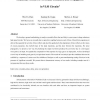6 search results - page 1 / 2 » Analytical models for crosstalk excitation and propagation i... |
TCAD
2002
13 years 4 months ago
2002
We develop a general methodology to analyze crosstalk effects that are likely to cause errors in deep submicron high speed circuits. We focus on crosstalk due to capacitive coupli...
ICCD
2001
IEEE
14 years 1 months ago
2001
IEEE
Abstract-- Scaling the minimum feature size of VLSI circuits to sub-quarter micron and its clock frequency to 2GHz has caused crosstalk noise to become a serious problem, that degr...
ITC
1998
IEEE
13 years 9 months ago
1998
IEEE
This paper addresses the problem of efficiently and accurately generating two-vector tests for crosstalk induced effects, such as pulses, signal speedup and slowdown, in digital c...
VLSID
2006
IEEE
14 years 5 months ago
2006
IEEE
For a nanoCMOS of sub-65nm technology, where the gate oxide (SiO2) thickness is very low, the gate leakage is one of the major components of power dissipation. In this paper, we pr...
ISVLSI
2005
IEEE
13 years 10 months ago
2005
IEEE
— Direct tunneling current is the major component of static power dissipation of a CMOS circuit for technology below 65nm, where the gate dielectric (SiO2) is very low. We intuit...

